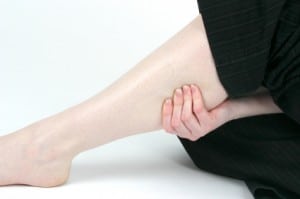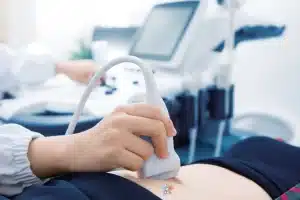by Patricia Hughes

Leg cramps are a common discomfort in pregnancy, particularly in the third trimester. The sudden cramping and tightening of the calf muscles is extremely painful and often happens at night, causing you to wake in pain from a peaceful sleep.
The exact cause of leg cramps is not known, but there are some factors believed to contribute to leg cramps. The increased weight of pregnancy, changes in blood circulation and pressure on the nerves from the growing baby are believed to cause the discomfort in the legs. The best way to deal with leg cramps is to prevent them.
Table of Contents
Preventing Leg Cramps
There are some things you can do to prevent leg cramps. Standing or sitting for too long at one time can cause leg cramping. If your job requires you to stand or sit for extended periods of time, take breaks throughout the day. Put your feet up if you stand for work and get up and walk around periodically if you sit at a desk.
How you are sitting can also contribute to leg cramping. Avoid crossing your legs when you are sitting. Circulation is decreased when the legs are crossed. Sitting with your feet elevated at the end of the day or on breaks helps improve the circulation, which can help reduce cramping.
When you do get up, stretching the leg muscles can help prevent cramping. Stretch the calf muscles during the day and before you go to bed at night, since this is when cramping is most common. Walking is another way to improve the circulation in your legs and stretch the muscles.
How you sleep at night influences your circulation. Lying on the left side at night is the best sleeping position for increasing blood circulation. This is important for cramping, as well as bringing more oxygen to your body and your baby.
Regular exercise is good for your circulation. There are many benefits to exercising in pregnancy, including fewer leg cramps, reduced risk of certain complications, controlling weight gain and preparing the body for labor. Swimming, walking and prenatal yoga are forms of exercise that increase circulation, can reduce leg cramps and are gentle. Ask your doctor or midwife before starting a new exercise routine during pregnancy.
There is evidence to suggest certain supplements can help with cramping. The theory is that low levels of calcium or magnesium can be responsible for increased cramping. The science is mixed on whether taking additional supplements is helpful, but might be worth trying for recurring cramps. Speak to your health care provider before adding additional supplements to your daily regimen.
Dehydration can contribute to leg cramping. If you experience leg cramping, pay careful attention to stay well hydrated. Take a water bottle with you to work or when out running errands. Sipping water throughout the day helps you stay well hydrated, which can reduce leg cramps.
Dealing with Leg Cramps
Despite the best prevention efforts, cramping can still happen. When you are struck with a cramp in the middle of the night, the pain is sudden and intense. To loosen the muscles and relieve the cramp, stretch the leg, flex the foot and move the toes around to work the cramp out. Avoid pointing the toes, which can intensify the cramping.
Stand up and walk around until it stops. This will be uncomfortable at first, but continuing to walk around the bedroom helps to stretch the muscles and increase the circulation in your legs. Taking a warm bath, using a hot water bottle or massaging the calf muscles can also be helpful for stopping the cramp when they happen.
When to Worry about Leg Cramps
Although leg cramps are a fairly common discomfort and usually require no medical treatment, not all leg cramps are benign. Some things to watch out for include constant pain in the calf muscles, tenderness and swelling. This can be a sign of a blood clot in the leg, which can be very serious or life threatening, if the clot breaks off. Symptoms of blood clots should never be ignored.
According to the American Society of hematology, women are at increased risk of developing clots during pregnancy. A family history of blood clots, obesity and bed rest increase this risk and could lead to complications in the pregnancy or danger to the health of the mother. As a result, it’s important to watch out for the warning signs and report them to your doctor immediately.
More information on leg cramps in pregnancy is available through the March of Dimes .
Patricia Hughes is a freelance writer and mother of four. Patricia has a Bachelor’s Degree in Elementary Education from Florida Atlantic University. She has written extensively on pregnancy, childbirth, parenting and breastfeeding. In addition, she has written about home décor and travel.
No part of this article may be copied or reproduced in any form without the express permission of More4Kids Inc © and All Rights Reserved












Add Comment